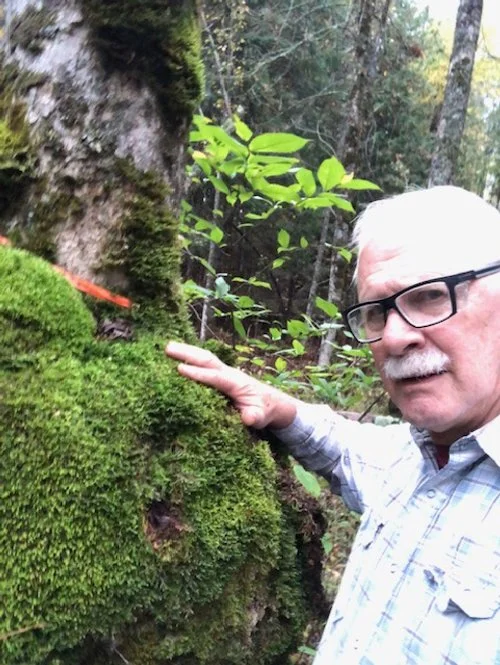A Big Black Ash burl
A four foot diameter Black ash burl, completely encircling the tree. Even from the photos, I could guess that it is an eyed burl because of its symmetric and spherical shape, also since eyed burls are is very common on Black ash, and also that it is a good quality burl when the burl is much bigger than the diameter of the tree and the bark is all intact. I can see that the moss covers about 1/4 of the burl and that wood is more likely to be spalted or even rotten because of being kept moist and out of the sun on the North side of the tree.
In the fall if 2023, I received a phone call from a woman about 5 hours north of the Twin Cities of Minnesota where I live. She has a large burl that she wanted to sell to me. She had seen my newspaper ad in their local newspaper many months before but finally decided to call me when they decided to sell their home and woodlot. She sent photos with a ruler included so I could see that it was a large Black ash burl, about 4 feet in diameter that completely circled the trunk. She said it was about a half mile from the nearest road. I offered her $500, assuming that it was an eyed Black ash burl in good condition and that I would harvest the whole tree to take the burl. I might have offered her more but I had a lot of driving and expenses just to get there. I also offered her $50 for the use of their ATV to haul out the pieces of the burl.
I arranged a day to come, rented a trailer, drove the 5 hours and stayed overnight nearby. Early the next morning I arrive at her house, and we talked some, parked the trailer close to the trail to the tree. Her husband took me in the ATV to the burl site and I immediately knew I’d made a good call on this burl. It was big and looked solid. We had a big job ahead to get it out of the woods. I noticed there was a lot of moss on the north side of the tree, away from southern direct sunlight, and as I pulled some of that off, I could see that there was some spalting in the bark and probably in the wood below, not necessarily a negative since the spalting is its own special effect if the wood is not so “punky” that it can’t be turned.
It’s love.
I cut down the tree, first dropping the top, and then cutting under the burl to drop it so I could see it and work on cutting it up. If I had heavy equipment and access to my trailer, I would not have cut it up until I had hauled it home and then dried it. But, it was going to be tough to haul even smaller pieces the distance to my trailer and, truth be told, I was going to have to cut it up anyway. One advantage of cutting it up on hte scene and not having to use heavy equipment is the bark would be in pristine shape. For natural edge turners like me, that is a real plus.
So, I looked at the burl and searched for the signs on the outside of where I should cut. For example, above, see the row of rougher bark 1/3 of the way up the burl at a slight angle. That is probably a border between smaller burls that has grown together, includes a bark inclusion, and is a good place to cut. Other signs would be cracks, holes in the bark, and insect activity. On the photo above, I definitely left the larger clear burl above it, 18 inches in diameter, for a nest of larger bowls. So, below is my pile of cut pieces, almost all hauled by this point. We loaded it onto the ATV and my host hauled it up next to my trailer, tough going through the woods and maybe one of the last trips this old vehicle could handle.
It took 6 trips with the ATV, and the last time it stalled and needed some encouragement. Each load was quite heavy. When we had loaded everything, we cleaned up and headed to the trailer, where I loaded the chunks of burl, a precious load, that eventually yielded 75-85 bowls, nests and even multiple nests of cored bowls from every chunk we harvested and hauled. One thing I always notice is that the tree, the burl and the chunks look much bigger when you get them out of the woods. This burl yielded many chunks that would yield 14-16 inch bowls. They are big, and seemed progressively bigger as I got them out of the woods, to my trailer, and finally into my shop and on to my bandsaw and lathe.
We thanks our hosts, paid them, and headed home. When I got home, I immediately coated all cut surfaces of the burl chunks with end grain sealer. Those surfaces are vulnerable to cracking until they are turned, but I also want to dry the wood for a few weeks at least. The sealer helps protect them. I would also never leave them out in the sun, where the stresses would be too great.
This is a 16 inch diameter outside bowl with 6 more coming from the inside, down to 5 inches at the center.









